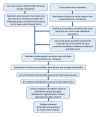Combating the COVID-19 pandemic in a resource-constrained setting: insights from initial response in India
- PMID: 33187963
- PMCID: PMC7668115
- DOI: 10.1136/bmjgh-2020-003416
Combating the COVID-19 pandemic in a resource-constrained setting: insights from initial response in India
Abstract
The low-and-middle-income country (LMIC) context is volatile, uncertain and resource-constrained. India, an LMIC, has put up a complex response to the COVID-19 pandemic. Using an analytic approach, we have described India's response to combat the pandemic during the initial months (from 17 January to 20 April 2020). India issued travel advisories and implemented graded international border controls between January and March 2020. By early March, cases started to surge. States scaled up movement restrictions. On 25 March, India went into a nationwide lockdown to ramp up preparedness. The lockdown uncovered contextual vulnerabilities and stimulated countermeasures. India leveraged existing legal frameworks, institutional mechanisms and administrative provisions to respond to the pandemic. Nevertheless, the cross-sectoral impact of the initial combat was intense and is potentially long-lasting. The country could have further benefited from evidence-based policy and planning attuned to local needs and vulnerabilities. Experience from India offers insights to nations, especially LMICs, on the need to have contextualised pandemic response plans.
Keywords: control strategies; health policy; health systems; prevention strategies; public health.
© Author(s) (or their employer(s)) 2020. Re-use permitted under CC BY-NC. No commercial re-use. See rights and permissions. Published by BMJ.
Conflict of interest statement
Competing interests: None declared.
Figures
References
-
- The World Bank Low & middle income | Data. Available: https://data.worldbank.org/income-level/low-and-middle-income [Accessed 28 Apr 2020].
Publication types
MeSH terms
LinkOut - more resources
Full Text Sources
Medical
Miscellaneous


